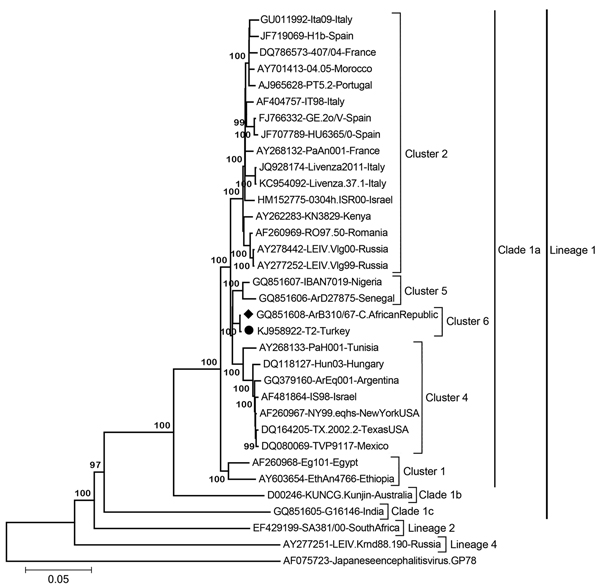Volume 21, Number 2—February 2015
Dispatch
Close Relationship between West Nile Virus from Turkey and Lineage 1 Strain from Central African Republic
Figure 1

Figure 1. Neighbor-joining phylogenetic tree constructed on the basis of the complete genomic nucleotide sequences of selected West Nile virus (WNV) strains, including isolate T2 from Turkey (black dot) and the closely related strain ArB310/67 from the Central African Republic (black diamond). Major WNV lineages, clades, and clusters are indicated, except for the local cluster 3 (12). Bootstrap values of major branches are given for 1,000 replicates. Virus strains are described by GenBank accession number, name, and country of isolation. Japanese encephalitis virus strain GP78 served as outgroup. Scale bar indicates substitutions per site.
References
- Burke D, Monath T. Flaviviruses. In: Knipe DM, Howley PM, editors. Fields virology. Philadelphia: Lippincott William & Wilkins; 2001. p. 1043–126.
- Hayes EB, Gubler DJ. West Nile virus: epidemiology and clinical features of an emerging epidemic in the United States. Annu Rev Med. 2006;57:181–94 . DOIPubMedGoogle Scholar
- Calistri P, Giovannini A, Hubalek Z, Ionescu A, Monaco F, Savini G, Epidemiology of West Nile in Europe and in the Mediterranean Basin. Open Virol J. 2010;4:29–37.PubMedGoogle Scholar
- Lanciotti RS, Roehrig JT, Deubel V, Smith J, Parker M, Steele K, Origin of the West Nile virus responsible for an outbreak of encephalitis in the northeastern United States. Science. 1999;286:2333–7 . DOIPubMedGoogle Scholar
- Komar N, Clark GG. West Nile virus activity in Latin America and the Caribbean. Rev Panam Salud Publica. 2006;19:112–7 . DOIPubMedGoogle Scholar
- Ergunay K, Whitehouse CA, Ozkul A. Current status of human arboviral infections in Turkey. Vector Borne Zoonotic Dis. 2011;11:731–41 . DOIPubMedGoogle Scholar
- Kalaycioglu H, Korukluoglu G, Ozkul A, Oncul O, Tosun S, Karabay O, Emergence of West Nile virus infections in humans in Turkey, 2010 to 2011. Euro Surveill. 2012;17:20182 .PubMedGoogle Scholar
- Ozkul A, Ergunay K, Koysuren A, Alkan F, Arsava EM, Tezcan S, Concurrent occurrence of human and equine West Nile virus infections in Central Anatolia, Turkey: the first evidence for circulation of lineage 1 viruses. Int J Infect Dis. 2013;17:e546–51 . DOIPubMedGoogle Scholar
- Ergunay K, Gunay F, Oter K, Kasap OE, Orsten S, Akkutay AZ, Arboviral surveillance of field-collected mosquitoes reveals circulation of West Nile virus lineage 1 strains in Eastern Thrace, Turkey. Vector Borne Zoonotic Dis. 2013;13:744–52 . DOIPubMedGoogle Scholar
- Ergunay K, Gunay F, Kasap OE, Oter K, Gargari S, Karaoglu T, Serological, molecular and entomological surveillance demonstrates widespread circulation of West Nile virus in Turkey. PLoS Negl Trop Dis. 2014;8:e3028 . DOIPubMedGoogle Scholar
- Bakonyi T, Ivanics E, Erdelyi K, Ursu K, Ferenczi E, Weissenböck H, Lineage 1 and 2 strains of encephalitic West Nile virus, central Europe. Emerg Infect Dis. 2006;12:618–23 . DOIPubMedGoogle Scholar
- May FJ, Davis CT, Tesh RB, Barrett AD. Phylogeography of West Nile virus: from the cradle of evolution in Africa to Eurasia, Australia, and the Americas. J Virol. 2011;85:2964–74 . DOIPubMedGoogle Scholar
- Brault AC, Huang CY, Langevin SA, Kinney RM, Bowen RA, Ramey WN, A single positively selected West Nile viral mutation confers increased virogenesis in American crows. Nat Genet. 2007;39:1162–6. DOIGoogle Scholar
- Moudy RM, Meola MA, Morin LL, Ebel GD, Kramer LD. A newly emergent genotype of West Nile virus is transmitted earlier and more efficiently by Culex mosquitoes. Am J Trop Med Hyg. 2007;77:365–70 .PubMedGoogle Scholar
- Shah-Hosseini N, Chinikar S, Ataei B, Fooks AR, Groschup MH. Phylogenetic analysis of West Nile virus genome, Iran. Emerg Infect Dis. 2014;20:1419–21 . DOIPubMedGoogle Scholar
Page created: January 21, 2015
Page updated: January 21, 2015
Page reviewed: January 21, 2015
The conclusions, findings, and opinions expressed by authors contributing to this journal do not necessarily reflect the official position of the U.S. Department of Health and Human Services, the Public Health Service, the Centers for Disease Control and Prevention, or the authors' affiliated institutions. Use of trade names is for identification only and does not imply endorsement by any of the groups named above.